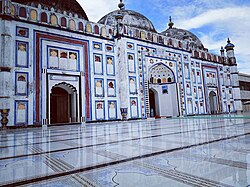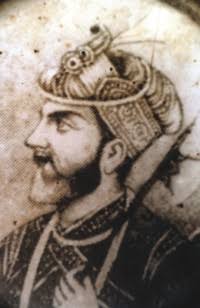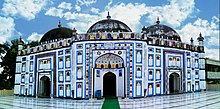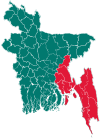Sarail Upazila
Sarail
সরাইল | |
|---|---|
 | |
 | |
| Coordinates: 24°7.1′N 91°7.5′E / 24.1183°N 91.1250°E | |
| Country | |
| Division | Chittagong |
| District | Brahmanbaria |
| Area | |
• Total | 239.52 km2 (92.48 sq mi) |
| Population | |
• Total | 364,369 |
| • Density | 1,500/km2 (3,900/sq mi) |
| Time zone | UTC+6 (BST) |
| Postal code | 3430[2] |
| Area code | 08527[3] |
| Website | Official Website of Sarail |
Sarail (Bengali: সরাইল, romanized: Shorail) is an upazila of Brahmanbaria District[4] located in the Chittagong Division and near the Dhaka Division, Bangladesh.
History
[edit]


The leader of the Baro-Bhuiyan zamindars, Isa Khan, had his first and temporary capital situated in Sarail.[5] During the Mughal era, Sarail was a mahallah (district) of the Sylhet Sarkar.[6]
During the dewani of Dewan Shahbaz Khan in 1650, the Hatirpul was constructed. It was a bridge built over the canal mainly for elephant pass. The Mughal dewans used to communicate by the elephant in this road and also took rest near this bridge. In 1662, the Arifil Mosque was constructed by Shah Arif. There are unknown tombs located near the mosque, supposedly belonging to the wives of Isa Khan.
During the Bangladesh Liberation War of 1971, the Pakistani Army killed about 70 innocent people in the Bitghar area. On 5 May, the freedom fighters raided the Pakistani Army's camp in the Shahbazpur area and killed 9 Pakistani soldiers; one freedom fighter was killed during this raid. A number of Pakistani Army officers and the chairman of the Sarail Peace Committee were also killed. The freedom fighters set up a mine bomb north of Kalikaccha Bazar. This exploded and destroyed two military vehicles. Three mass graves remain in Sarail. Memorial monuments were established in the upazila's Bitghar area, the Annada Government High School, the Sarail Degree College and also a monument dedicated to the martyr Sheikh Mesbahuddin Saraili.
In 1990, Sarail was made an upazila of Bangladesh.[4]
Geography
[edit]Sarail is located at 24°07′06″N 91°07′30″E / 24.118333°N 91.125°E. It has 43,854 households and a total area of 227.22 km2.[4]
Demographics
[edit]According to the 2011 Census of Bangladesh, Sarail Upazila had 58,622 households and a population of 315,208. 102,749 (32.60%) were under 10 years of age. Sarail had a literacy rate (age 7 and over) of 40.85%, compared to the national average of 51.8%, and a sex ratio of 1068 females per 1000 males. 46,927 (14.89%) lived in urban areas.[8]
According to the 1991 Bangladesh census, Sarail had a population of 254,481. Males constituted 50.32% of the population, and females 49.68%. The population aged 18 or over was 120,249. Sarail had an average literacy rate of 22.6% (7+ years), against the national average of 32.4%.[9]
Administration
[edit]Sarail Upazila is divided into nine union parishads: Auraol, Chunta, Kalikachchha, Noagaon, Pakshimul, Panishor, Sarail, Shahbazpur, and Shahjadapur. The union parishads are subdivided into 67 mauzas and 141 villages.[8]
Upazila Chairman: Rafique Uddin Thakur [10]
Notable residents
[edit]- Nurul Amin, Prime Minister of Pakistan
- Dewan Mahbub Ali,Dewan Mahbub Ali (Qutub Mia) was an elected member of the National Assembly (MLA) of the United Front in 1954. He was the leader of world opinion formation at the peace conference in Budapest, Hungary in the liberation war of 1971, he was the former general secretary of the Adamji Jute Mill Workers Union, the former vice-president of the central committee of NAP, and a prominent lawyer.[11]
- Sheuly Azad, Member of Parliament, lives in West Kuttapara.[12]
- Abdus Sattar Bhuiyan
- Ullaskar Dutta, Indian revolutionary
- Isa Khan, first chief of the Baro-Bhuiyan confederacy which resisted the Mughal rule in Bengal
- Ismail Khan, brother of Isa Khan
- Masum Khan, zamindar and Mughal Army officer
- Musa Khan, second chief of the Baro-Bhuiyans of Bengal
- Habibur Rahman Milon, journalist
- Ahmed Rafiq, writer and researcher
- Taher Uddin Thakur, Minister of State for Information
- Barrister Rumeen Farhana, member of parliament
- Sheikh shamim, member, national executive comity, bnp
See also
[edit]References
[edit]- ^ National Report (PDF). Population and Housing Census 2022. Vol. 1. Dhaka: Bangladesh Bureau of Statistics. November 2023. p. 396. ISBN 978-9844752016.
- ^ "Bangladesh Postal Code". Dhaka: Bangladesh Postal Department under the Department of Posts and Telecommunications of the Ministry of Posts, Telecommunications and Information Technology of the People's Republic of Bangladesh. 20 October 2024.
- ^ "Bangladesh Area Code". Stockholm, Sweden: Rebtel.com. 18 October 2024.
- ^ a b c Md. Azad Uddin Thakur (2012). "Sarail Upazila". In Sirajul Islam; Miah, Sajahan; Khanam, Mahfuza; Ahmed, Sabbir (eds.). Banglapedia: the National Encyclopedia of Bangladesh (Online ed.). Dhaka, Bangladesh: Banglapedia Trust, Asiatic Society of Bangladesh. ISBN 984-32-0576-6. OCLC 52727562. OL 30677644M. Retrieved 2 January 2025.
- ^ AA Sheikh Md Asrarul Hoque Chisti (2012). "Isa Khan". In Sirajul Islam; Miah, Sajahan; Khanam, Mahfuza; Ahmed, Sabbir (eds.). Banglapedia: the National Encyclopedia of Bangladesh (Online ed.). Dhaka, Bangladesh: Banglapedia Trust, Asiatic Society of Bangladesh. ISBN 984-32-0576-6. OCLC 52727562. OL 30677644M. Retrieved 2 January 2025.
- ^ Nath, Pratyay (28 Jun 2019). Climate of Conquest: War, Environment, and Empire in Mughal North India. Oxford University Press.
- ^ Population and Housing Census 2022 - District Report: Brahmanbaria (PDF). District Series. Dhaka: Bangladesh Bureau of Statistics. June 2024. ISBN 978-984-475-275-7.
- ^ a b "Bangladesh Population and Housing Census 2011 Zila Report – Brahmanbaria" (PDF). bbs.gov.bd. Bangladesh Bureau of Statistics.
- ^ "Population Census Wing, BBS". Archived from the original on 2005-03-27. Retrieved November 10, 2006.
- ^ "Leaders". Sarail Upazila.
- ^ "Constituency 312_11th_En". Bangladesh Parliament. 1954.
- ^ "Constituency 312_11th_En". Bangladesh Parliament. Retrieved 11 September 2020.

